Raaga Based Song of the Day: Sawan ka mahina pawan kare sor…
Raag Pahadi, Tal Kaherava
Yesterday was the Birth Anniversary of singer Mukesh (this post was meant to be published on 23rd Jul but I broke my reading glasses!) and I gave you one of his best raaga based songs; in Raag Maru Bihag, Tal 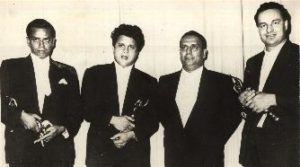 Kaherava: Matwali naar thumak thumak chali jaaye, a song put together by all the greats: Shailendra, Shankar Jaikishan and Mukesh.
Kaherava: Matwali naar thumak thumak chali jaaye, a song put together by all the greats: Shailendra, Shankar Jaikishan and Mukesh.
Mukesh, of course, was the singer who won the first ever Filmfare Award for a Singer with his song Sab kuchh seekha hamane na seekhi for the 1959 Raj Kapoor movie Anari with the same team.
And today, I am back with another song that he sang for the 1967 Adurthi Subba Rao movie Milan. Coincidentally, the song has been pictured on Sunil Dutt again, this time with Nutan.
Why this song? Well, need you guess? It is in the raag of my home-station: Pahadi and this is the fourth occasion that I am giving you one composed in this raag. Normally, in order to come up with popular tunes, the composers take lots of liberties with the raag; it is not their concern to maintain purity of raag but to come up with catchy tunes. However, in this song, Laxmikant Pyarelal have stayed as close as possible to Pahadi.
We have completed forty-four days of Raaga Based Songs of the Day. Our first post in the series was titled ‘Raaga Based Song Of The Day #1’ and the song was a Mohammad Rafi and Lata Mangeshkar song from the 1970 Shakti Samanta movie Pagla Kahin Ka: Tum mujhe youn bhula na paoge. It is in Raag Jhinjhoti, Tal Kaherava.
Our forty-fifth post was titled ‘Raaga Based Song Of The Day #45‘ and the song was a Mukesh song from the 1960 Bhappie Sonie Ek Phool Chaar Kaante: Matwali naar thumak thumak chali jaaye. It is in Raag Maru Bihag, Tal Kherava.
This blog has a number of posts on Raaga based songs in Hindi movies titled similarly; for example: ‘The Best Raaga Based Songs in Hindi Movies – Raaga Yaman – Part II‘.
In the last forty-five days of sharing Raaga based songs of the day, I have given you songs based on Raag Jhinjhoti, Gara, Bhimpalasi, Madhuvanti, Shivaranjani, Bihag, Pahadi, Sarang, Pilu, Bhairavi, Khammaj, Charukesi, Kalyan or Yaman, Desh, Malgunji, Kirwani, Kedar, Bageshri, Megh Malhar, Bhupali, Ahir Bhairav, Malkaush, Adana, Kafi, Rageshri, Jaunpuri, Tilang, Janasammohini, Chayanat, Shuddha Kalyan, Gaur Sarang, Jogiya, Asavari, Maru Bihag, Durga, Lalit, Puria Dhanashri, Bhinna Sahdja, Sohani, Multani and Patdeep. The only two raag that has been repeated so far are Pahadi, the raaga of my home place in the Himalayas, and Maru Bihag.
Today, I give you a song in Raag Pahadi, Tal Kaherava.
However, first, lets take up the value added learning of today. Today, we shall learn about – you can very well guess it – the musical instrument that goes best with Pahadi, that is, Bansuri or Flute:
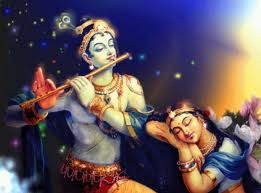 Bansuri is the most loved of Indian musical instruments. And the reason is that our most adored god, Lord Krishna, used to play it. So much so that an Indian cannot think of Bansuri without relating it to Krishna and Ras Leela with Radha and Gopikas.
Bansuri is the most loved of Indian musical instruments. And the reason is that our most adored god, Lord Krishna, used to play it. So much so that an Indian cannot think of Bansuri without relating it to Krishna and Ras Leela with Radha and Gopikas.
Bansuri used to be the instrument of choice in Hindi movies for heroes to call the heroine (in the likeness of Radhe-Krishna) and there are hundreds of songs with Bansuri, if not thousands.
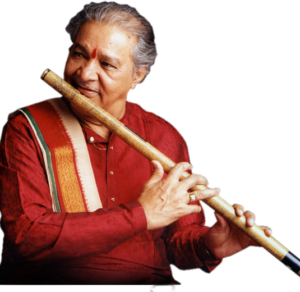
During my younger days, when my brother was studying in St. Xaviers College, Mumbai, I used to attend, with him, over-night Indian Classical Music concerts. One of the most sought after items in the itinerary used to be Bansuri-Vaadan by Padma Vibushan Pandit Hari Prasad Chaurasia, the most accomplished bansuri player in the world. Just like raag Pahadi, the sound of Bansuri immediately transports you to another world.
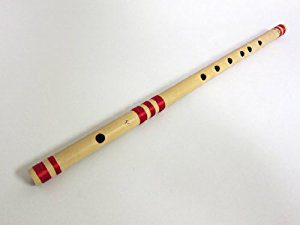 Bansuri is an aerophone, originally made of bamboo. However, these days one sees Bansuris made of metals, fibreglass and even ivory. Bansuri’s origin is Bans (Bamboo) plus Sur (Notes or Melody). The length of the Bansuri is between 12 to 30 inches. Sound is produced by resonating air column trapped inside the Bansuri. Various swar are produced by changing the length of the air-column by opening one of the six to eight holes that are manipulated by fingers of both the hands.
Bansuri is an aerophone, originally made of bamboo. However, these days one sees Bansuris made of metals, fibreglass and even ivory. Bansuri’s origin is Bans (Bamboo) plus Sur (Notes or Melody). The length of the Bansuri is between 12 to 30 inches. Sound is produced by resonating air column trapped inside the Bansuri. Various swar are produced by changing the length of the air-column by opening one of the six to eight holes that are manipulated by fingers of both the hands.
In South Indian or Carnatic music, a similar flute is called Venu. Bansuri is regarded amongst the most ancient of Indian musical instruments. It is called Nadi and Tunava in the Rigveda and others. Sanskrit treatise Natya Shastra has extensive mention of Bansuri.
There are two varieties of bansuri: the transverse, and the fipple. The fipple variety is usually played in folk music and is held away from the lips like a whistle. Because of the flexibility and control it offers, the transverse variety is preferred in classical music. It is played by blowing into a hole close to the closed end of the Bansuri.
Pandit Pannalal Ghosh (1911-1960) elevated the Bansuri from a folk instrument into serious classical music. He improvised with the length and number of holes and eventually came up with longer bansuris with larger bores and a seventh hole placed 90 degrees around from the line of the other six holes. Longer bansuris provided better coverage in the lower octaves. Hence, eventually, we have Bansuris ranging from 7.5 inches to 42 inches in length.
The distance of a finger-hole from the mouth-hole, and the diameter of the finger-hole controls the note it plays. Adjustments to the diameters of various holes is made by the artisans to achieve purity of the musical notes produced. The wall thickness of the Bansuri determines the tone, range and octave tuning.
Six holes are sufficient to produce the seven basic Swaras: sa, re, ga, ma, pa, dha, and ni. When all holes are closed, it produces the bass scale, that is the root note of the Bansuri (pa). With one hole farthest from the closed end of the Bansuri open, the instrument plays the dha. Similarly, ni is produced with two farthest holes open, sa with three farthest open, ri with four, ga with five, and ma is produced with all holes open.
Every Bansuri by its design and construction has a specific key and tonal center, corresponding to sa.
As I mentioned, today’s song is composed in Raag Pahadi, Tal Kaherava.
I have already given you three songs in Pahadi: On the 7th day: Aaj ki raat piya dil na todo (Tal Dadra), on the 8th day: Zara sun haseena ai nazneen (Tal Rupaktal) and on the 32nd day: Chal udd jaa re panchhi (Tal Kaherava). If you recall, I had told you that Pahadi is as much a raag as a dhun. It belongs to Bilawal Thaat and Audhav-Audhav Jati, that is six each notes in Aaroha and Avroha. It is normally played in the first prahar of the night.
It is a very popular raaga for composing soings in Hindi movies. Some of the songs composed in this raaga are:
| 1. 2. 3. 4. 5. 6. 7. 8. 9. 10. 11. 12. 13. 14. 15. 16. 17. 18. 19. 20. 21. 22. 23. 24. 25. 26. 27. 28. 29. 30. 31. 32. 33. 34. 35. 36. 37. 38. 39. 40. |
Parbaton Ke Pedon Par Chahoonga Main Tujhe Baharon Mera Jeevan Jawa hai Muhobbat Chhod Babul Ka Ghar Chaudhavi Ka Chand Ho Tujhko Pukare Mera Door Koi Gaye Karvatein Badalte Rahe Meri Aankhon Mein Suhani Raat Dhal Tod Diya Dil Mera Isharon Isharon Mein Jane Kya Dhoonhati Tum Apna Ranj-o-Gam Apne Aap Raaton Mein Patta Patta Boota Boota Kahan Hai Tu Tum Na Aaye Sanam Deewana Mujhsa Nahin Sun Mere Saajana Saeeyan Bina Ghar Piya Bin Jiya Mehelon Ne Chheen Dil Ne Phir Aaja Re Chhoomkar Raat Sulaye Kaheen Ek Masoom Aawaz De Kahan Hai Mere Mundere Na Bol Aao Mil Jaayen Saanjh Bhayee Nahin Aaye Neela Aasma So gaya Ih hawaon Mein Main Tulsi Jeevan Se Na Haar Main Teri Chhoti Behena Kabhi To Milegi Bahaaron Ki Kanchi Re Kanchi Re Tum Jahan Ho |
Shagun Dosti Aakhri Khat Anmol Ghadi Babul Chaudhavi Ka Chand Neel Kamal Baiju Bawara Aapki Kasam Barsaat Dulari Andaaz Kashmir Ki Kali Shola Aur Shabnam Shagun Shankar Husain Ek Nazar Afsana Bhootnath Teesari Manzil Goonj Uthi Sehnaibr Aangan Ki Kali Dasi Jabak Dil Ne Phir Yaad Kiya Noorie Razia Sultan Shankar Husain Anmol Ghadi Parwana Prem Geet Shama Parwana Silsila Gumrah Main Tulsi Tere Aangan Ki Door Ka Rahi Soutan Aarti Hare Rama Hare Krishna Road To Sikkim |
Rafi, Suman Kalyanpur Rafi Lata Noorjahan Shamshad Rafi Rafi Shamshad, Lata, Rafi Kishore, Lata Lata Rafi Lata Rafi and Asha Rafi Jagjeet Kaur Lata Lata, Rafi Lata Lata Rafi Lata, Rafi Lata, Bhupendra Bhupendra Lata, Mukesh Rafi, Suman, Mukesh Lata, Nitin Mukesh Lata Rafi Noorejahan, Surendra Suraiya Suresh Wadekar, Anuradha Nirmala Devi Lata & Amitabh Mahendra, Asha Lata Kishore Kumar Lata Lata Kishore, Lata Mukesh |
I have, at various places earlier, told you about the commonest Tal in raagas: Kaherava and I know that by now you know enough about it.
Today’s song is from the 1967 Adurthi Subba Rao movie Milan starring Sunil Dutt and Nutan getting born in each life, only to be tied to each other in love. In their life depicted in the movie, Sunil Dutt is Gopinath, a poor orphan and a boatman and Nutan is Radha, the daughter of a Zamindar. Gopi transports Radha everyday across the river by his boat. One day, she tells him that she has to prepare a song for her college singing competition. And, he teaches her this. He insists on calling Shor (noise) as Sor (in the local dialect) and she eventually learns to sing it in the local dialect.
Nutan received the Filmfare Best Actress Award for her role in the movie and Laxmikant Pyarelal for Best Music Director. Even though Anand Bakshi missed getting the Best Lyricist award, many feel that the songs of the movie are amongst the best penned by him:
| 1 | “Sawan Ka Mahina” | Mukesh, Lata Mangeshkar |
| 2 | “Hum Tum Yug Yug Se (Part 1)” | Mukesh, Lata Mangeshkar |
| 3 | “Bol Gori Bol Tera Kaun Piya” | Mukesh, Lata Mangeshkar |
| 4 | “Aaj Dil Pe Koi” | Lata Mangeshkar |
| 5 | “Hum Tum Yug Yug Se (Part 2)” | Mukesh, Lata Mangeshkar |
| 6 | “Main To Diwana” | Mukesh |
| 7 | “Ram Kare Aisa Ho Jaye” | Mukesh |
| 8 | “Ye Geet Milan Ke” | Mukesh, Lata Mangeshkar |
| 9 | “Bol Gori Bol Tera Kaun Piya” | Mukesh, Lata Mangeshkar |
| 10 | “Aaj Dil Pe Koi Zor Chalta Nahin” | Lata Mangeshkar |
| 11 | “Tohe Sanwariya” | Lata Mangeshkar |
Please enjoy Mukesh and Lata sing one of the best songs composed in Raag Pahadi (by Laxmikant Pyarelal) on the lyrics of Anand Bakshi: Sawan ka mahina pawan kare sor….
Mu: saavan kaa mahiinaa, pavan kare sor
La: pavan kare shor
Mu: pavan kare sor
La: pavan kare shor
Mu: are bAbA shor nahI.n sor, sor, sor
La: pavan kare sor
HA.n, jiyaraa re jhuume aise, jaise banamaa naache mor
Ho saavan kaa mahiinaa …
Maujavaa kare kyaa jaane, hamako ishaaraa
Jaanaa kahaa.N hai puuchhe, nadiyaa kii dhaaraa
Marazii hai tumhaarii, le jaao jis or
Jiyaraa re jhuume aise …
Raamaa gajab Dhaae, ye purava_iyaa
Na_iyaa sambhaalo kit, khoe ho khiva_iyaa
Purava_iyaa ke aage, chale naa koii zor
Jiyaraa re jhuume aise …
Jinake balam bairii, gae hai.n bidesavaa
Laa_ii hai jaise unake, pyaar kaa sa.ndesavaa
Kaalii a.ndhiyaarii, ghaTaae.n ghanaghor
Jiyaraa re jhuume aise …
We have intended to learn about Raaga based music whilst we entertain ourselves with Raaga based songs. So, lets, once again, take stock of our collective learning so far:
- On the first day we learnt about the Raaga system devised by Pandit Vishnu Narayan Bhatkhande, which is the prevalent system in Hindustani Classical Music and based on ten Thaats.
- On the second day we learnt about Tal or Taal.
- On the third day we learnt about characteristics of Raagas that included Swar, Jati, Thaat, Arohana and Avarohana, Vadi, Samvadi and Pakad.
- On the fourth day, we learnt about Sargam.
- On the fifth day, we learnt about notations used in Indian classical music or simply Swar Lipi.
- On the sixth day, we learnt about the Ras (sentiments) that Raagas evoke.
- On the seventh day, we learnt about various types of Swar: Shuddha, Achal, Vikrut, Komal and Teevra.
- On the eighth day, we learnt the parts of a composition in Indian Classical Music.
- On the ninth day, we learnt the names of some of the popular instruments used in Indian Classical Music.
- On the tenth day, we learnt about the sources of names of Raagas.
- On the eleventh day, we learnt about why Bhairavi is the first raag to be taught to beginners and also why it is the last in a performance.
- On the twelfth day, we learnt about Khammaj Thaat.
- On the thirteenth day, we learnt about Tal Punjabi Theka or Sitarkhani.
- On the fourteenth day, we learnt about Alap.
- On the fifteenth day, we learnt about List of Raagas (Raagmala) in my favourite book: Sri Guru Granth Sahib.
- On the sixteenth day, we learnt about tips for raaga identification.
- On the seventeenth day, we learnt the basics of Gharana system.
- On the eighteenth day, we learnt about Filmi Sangeet.
- On the nineteenth day, we learnt about the commonest Tal in Raagas: Tintal.
- On the twentieth day, we learnt about the Kafi Thaat.
- On the twenty-first day, we learnt a little more in detail about the classification of Raagas.
- On the twenty-second day, we learnt the essential differences between Bhairavi and Bhairav.
- On the twenty-third day, we learnt a little more in detail about the Jati or Jaati of a raaga.
- On the twenty-fourth day, we learnt details of Thaat Bilawal, the most basic thaat in the Bhatkhande’s system of raagas.
- On the twenty-fifth day, we learnt about Tintal.
- On the twenty-sixth day, we learnt in detail about the Raaga – Samay linkage.
- On the twenty-seventh day, we learnt about Lehar.
- On the twenty-eighth day, we learnt about the history of the Hindustani Music.
- On the twenty-ninth day, we learnt about Dhrupad.
- On the thirtieth day, we learnt about Rupaktal that I was introduced to, a few months back, by my friend Anand Desai.
- On the thirty-first day, we learnt about Khayal.
- On the thirty-second day, we learnt about Thumri.
- On the thirty-third day, we learnt about Tappa.
- On the thirty-fourth day, we learnt about Tarana.
- On the thirty-fifth day, we learnt about Tal Dipchandi (Moghali).
- On the thirty-sixth day, we learnt about Tabla.
- On the thirty-seventh day, we learnt about Kirtan.
- On the thirty-eighth day, we learnt about Pakhawaj.
- On the thirty-ninth day, we learnt about Hori.
- On the fortieth day, we learnt about Dadra.
- On the forty-first day, we learnt about Kajri.
- On the forty-second day, we learnt about Chaiti.
- On the forty-third day, we learnt about Sarangi.
- On the forty-fourth day, we learnt about Shehnai.
- On the forty-fifth day, we learnt about Sarod.
- And today, on the forty-sixth day, we learnt about Bansuri.
There is much more still to be learnt and enjoyed.
Please stay tuned!
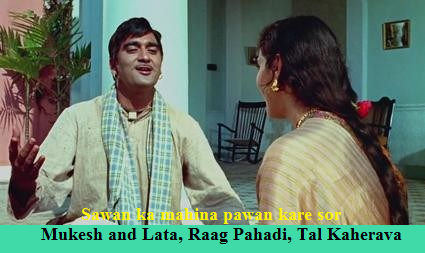
Superb lesson
Thanks Jaswant; Pahadi and Bansuri go heand in hand! Don’t you think?
Right Sir. The lads of sixties were very found of Bansuries and used to play it so well. In my village we have still two men , almost 15 -16 yrs elder to me , who are exceptional Bansuri Vadaks. As I had seen , in seventies in local village fares , Bansuri probably was the most sold item.